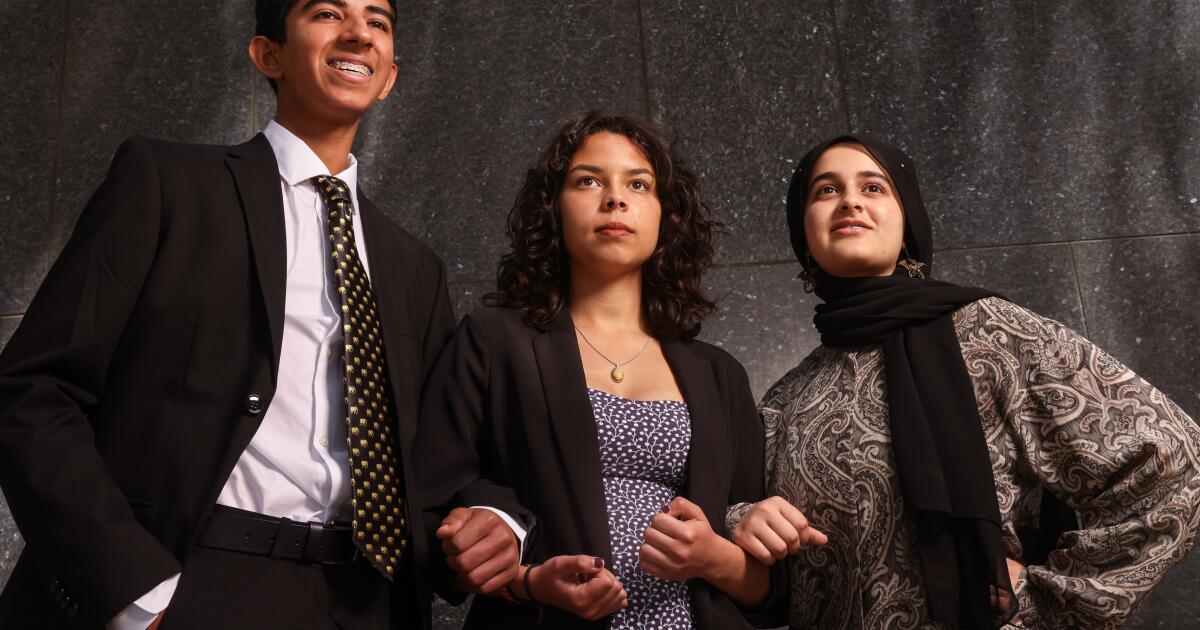Madigan Traversi’s world changed in the fall of 2017, but the forces responsible for her transformation had been brewing for a long time.
Late at night on Oct. 8, her family received a robocall about an evacuation warning — not an order — as more than a dozen wildfires tore through eight Northern California counties at once. They decided to flee their Sonoma County home to be safe. Just 20 minutes later, the house and all their possessions burned to the ground. Traversi was 12 years old.
When she started high school in 2019 and joined a climate activism group, she learned that uncharacteristically hot, dry and windy conditions helped fuel the Tubbs fire, which burned parts of Somona, Napa and Lake counties and caught people off guard. Twenty-two people died and more than 5,000 homes were destroyed. Entire neighborhoods were wiped out.
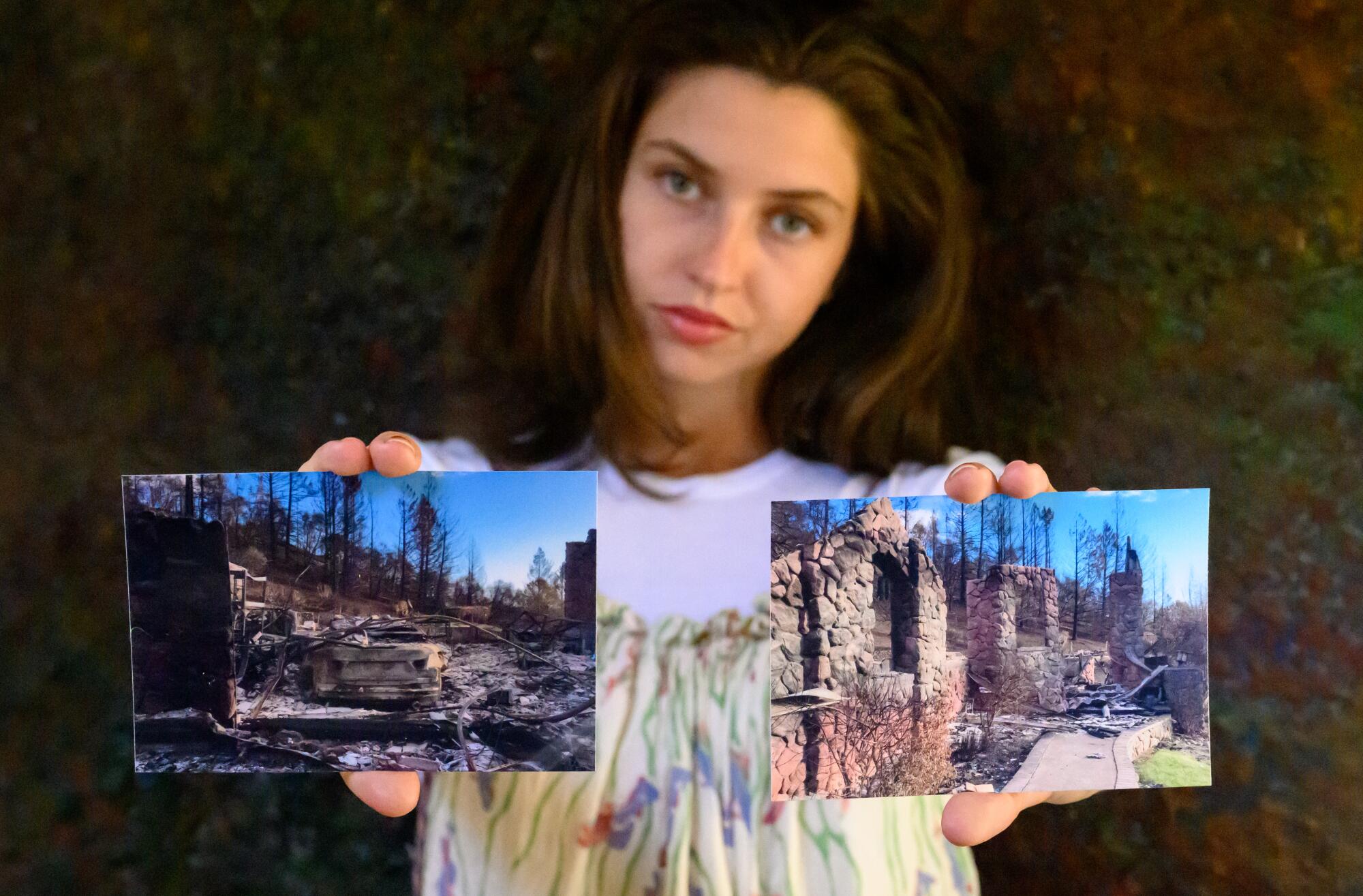
Madigan Traversi, 19, holds up photos of her Santa Rosa home, which burned down during the 2017 Tubbs fire.
(Josh Edelson / For The Times)
“That was the first time I was able to associate climate change with this wildfire I had been directly affected by,” said Traversi, now a 19-year-old activist and sophomore at UC Berkeley who promotes efforts to strengthen mental health supports for young people who have suffered climate disasters. “That sparked my passion.”
From staging protests to waging courtroom and legislative campaigns, a determined subset of California youths have been vocal in the fight against climate change. They’ve experienced firsthand an escalating drumbeat of environmental disasters — smog-choked air, extreme heat, searing drought, and devastating wildfires and floods — that unfold here season after season.
Experts say that exposure to these dramatic manifestations of the climate crisis has the potential to aggravate mental health impacts, including depression and anxiety, and that children and adolescents are disproportionately vulnerable. For some, turning to activism is one way to cope.
“It’s definitely been a way for me to combat these feelings of anxiety,” Traversi said. “Instead of feeling like there’s nothing I can do, I feel like I’m actively working to reverse this crisis.”

Research has confirmed that worry and anxiety associated with climate change are on the rise among young people, said Susan Clayton, professor of psychology at the College of Wooster, southwest of Akron, Ohio. Clayton has written multiple studies about how climate change affects the mental health of children and teens, including a landmark report released last year by the American Psychological Assn. and the nonprofit organization ecoAmerica.
“I would say one of the most striking things to me is the high level of concern and pessimism that you see around the world,” she said, referring to a 2021 survey of 10,000 young people in 10 countries, in which the majority of respondents said they feared for the future and that people had failed to take care of the planet.
Clayton has been talking to young people for eight years, and she’s noticed that many of them now report personally experiencing the effects — including extreme weather and fast-moving wildfires — of a warming world.
“These very tangible physical manifestations of climate change are things that people notice, and absolutely that makes it seem more real to them; therefore, it’s probably going to be more stressful,” she said. “One of the things about mental health is, it’s not just what you experience but how you interpret your experience that’s going to make a difference.”
Clayton is careful to note that climate anxiety alone is not a mental health problem: it’s a normal reaction to a real crisis. But it can lead to problems like clinical anxiety and depression, depending on a person’s other sources of stress and coping mechanisms, she said.
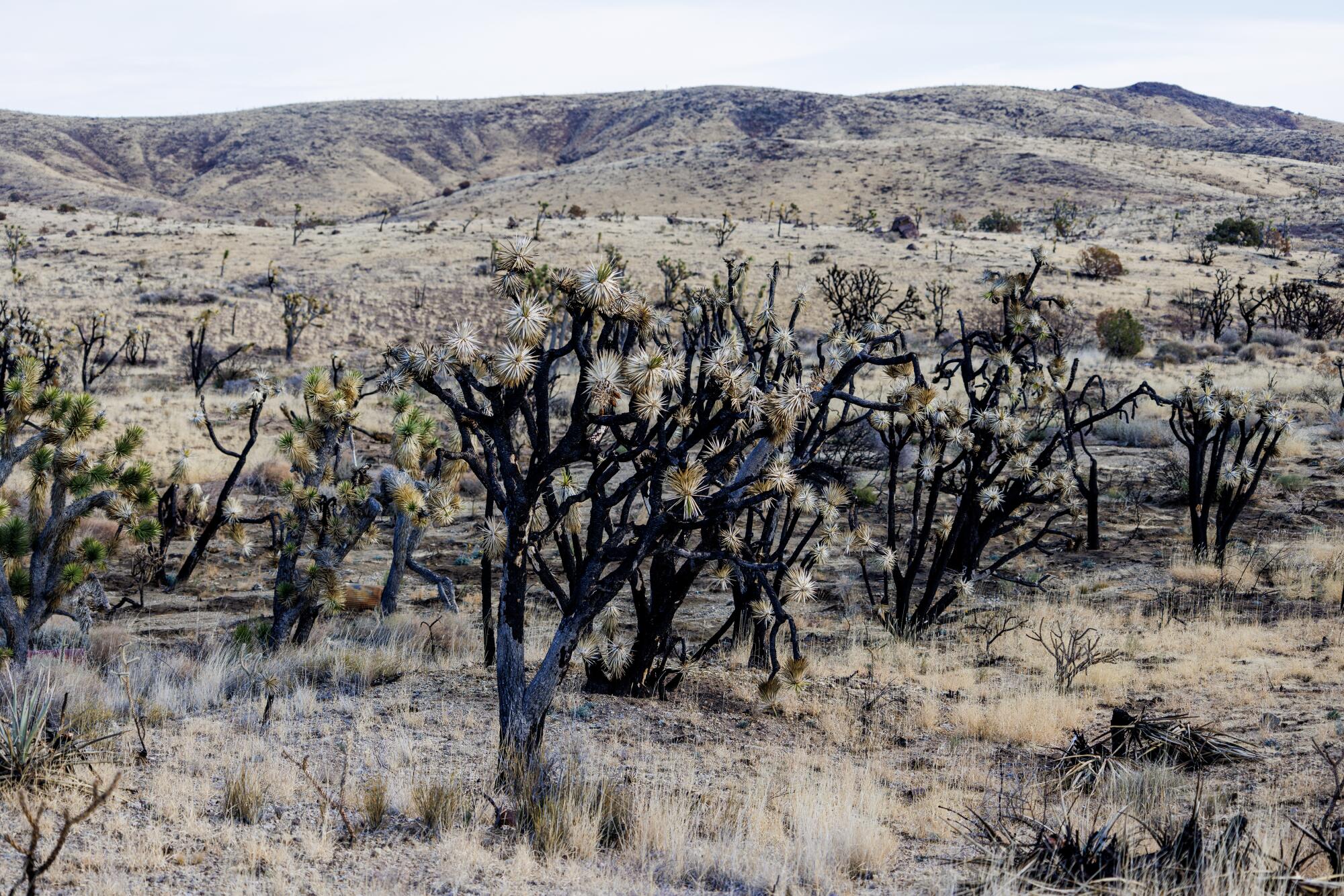
Charred Joshua trees fill the landscape six months after the York fire destroyed 93,000 acres in the Mojave National Preserve in July 2023.
(Gina Ferazzi / Los Angeles Times)
Young people, she added, are in some ways uniquely vulnerable. They’re dependent on adults — who, they believe, aren’t taking adequate action to address the crisis. That can aggravate feelings of powerlessness and contribute to psychological distress. Social support is a strong predictor of mental health, Clayton added.
“It’s bad enough to be afraid and anxious, but if you feel other people are not afraid and anxious about the same things, it can be really alienating.”
Research has further indicated that harsh and unpredictable environments, like those characterized by extreme heat, drought or storms, can impair social relationships and decision-making among adolescents, Clayton said. That can have long-term implications for both individuals and society, she said.
“They might decide it’s not worth putting effort into planning their careers or saving money because they don’t know what the world will look like in 20 years,” she said.

In some ways, Maryam is a typical 16-year-old. She likes reading, growing plants and spending time with her three cats — Bernie, Sanders and AOC. But it’s hard for her to picture her future.
“I go to school, but what’s the point of a degree if I’m not going to be able to use it for that long?” she said. “And I love school, I love school so much. It’s like my favorite thing. But it’s kind of useless at this point.”
The Orange County teenager used to look forward to an annual family trip among the tall trees at Big Basin Redwoods State Park. But four years ago, a massive lightning-sparked wildfire burned the campsite they frequented, along with the vast majority of the park. Another campsite Maryam used to visit with a youth camp in San Bernardino County also burned recently.
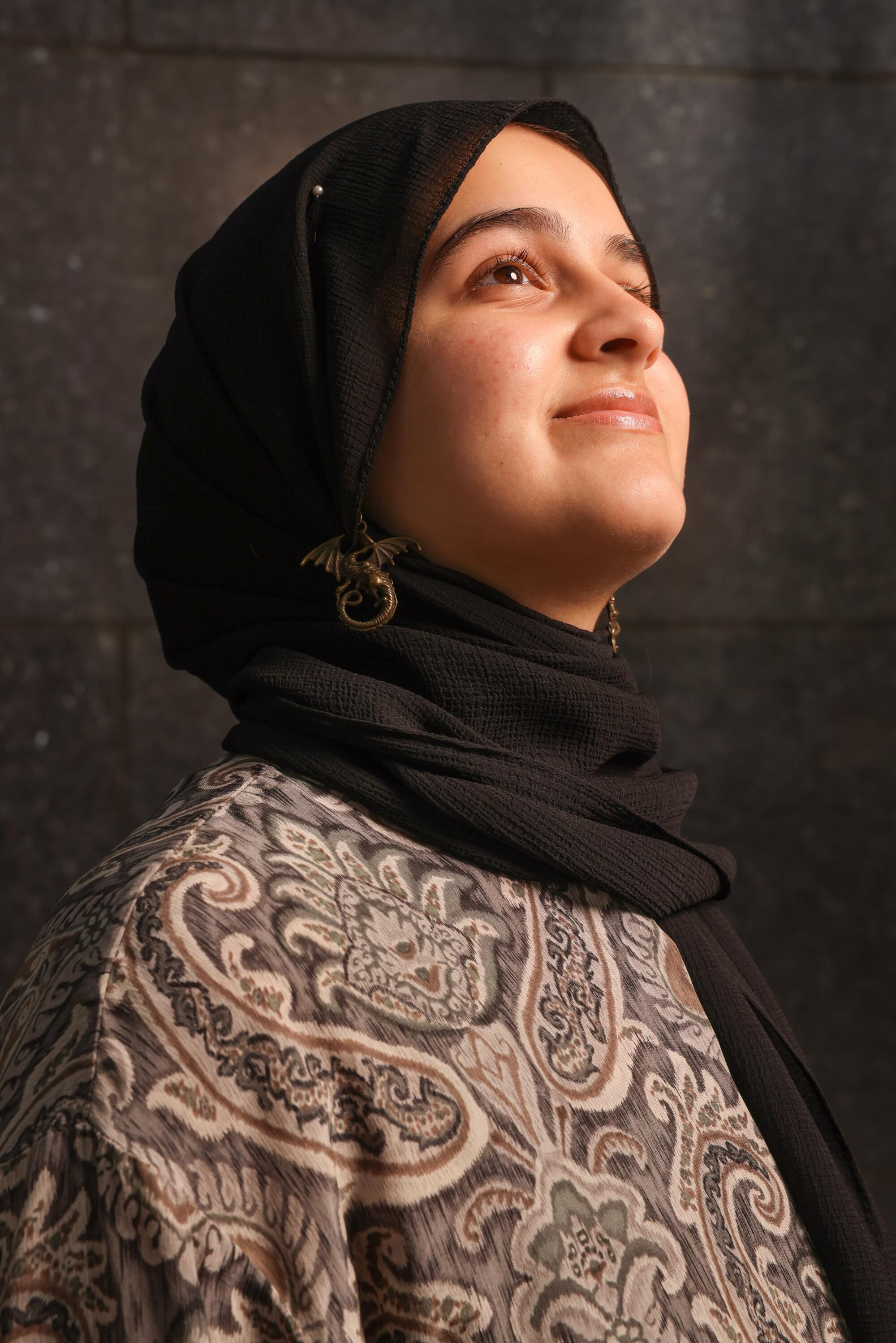
Maryam is one of three young plaintiffs who sued the EPA.
(Dania Maxwell / Los Angeles Times)
In the eighth grade, she started an activism group at her middle school that put up educational posters about climate change around campus and staged a protest at Fullerton City Hall urging the City Council to pay more attention to climate disasters. She became involved with the Sunrise Movement, a nonprofit that advocates for political action around climate change, and Fridays for Future, an international movement of students who stage climate strikes. She also volunteers with the youth board of her mosque.
And last year, Maryam was one of 18 California children to join a lawsuit against the Environmental Protection Agency alleging that it violated their constitutional rights by allowing pollution from burning fossil fuels to continue despite knowing the harms. (The Times is withholding the last names of the minors involved in that lawsuit at the request of their attorneys, with the Oregon-based nonprofit Our Children’s Trust, who fear the children could be targeted due to the litigation’s high-profile nature.)
A judge recently dismissed the action, ruling that the plaintiffs lacked legal standing because they did not show how the remedies they sought would mitigate those harms, but they amended and resubmitted their allegations.
“All the fear I had, I fueled it into energy,” Maryam said. “I don’t really think we have a choice anymore, because the adults aren’t doing anything. And if we wish to be able to go to the beach in 10 years or take a hike … ” she trailed off, choking back tears.
Maya, another plaintiff in the lawsuit, was diagnosed with asthma in 2019, after a severe wildfire season that covered the floor of her school gym in Santa Monica with ash. The 18-year-old now has to use an inhaler when she plays soccer.
While she had learned about climate change in school, she says teachers had told her everything would be fine if people took steps to reduce their carbon footprints, like recycling. That summer of smoke convinced her the crisis was more dire than she’d thought. She began to suffer crippling anxiety and started seeing a therapist.
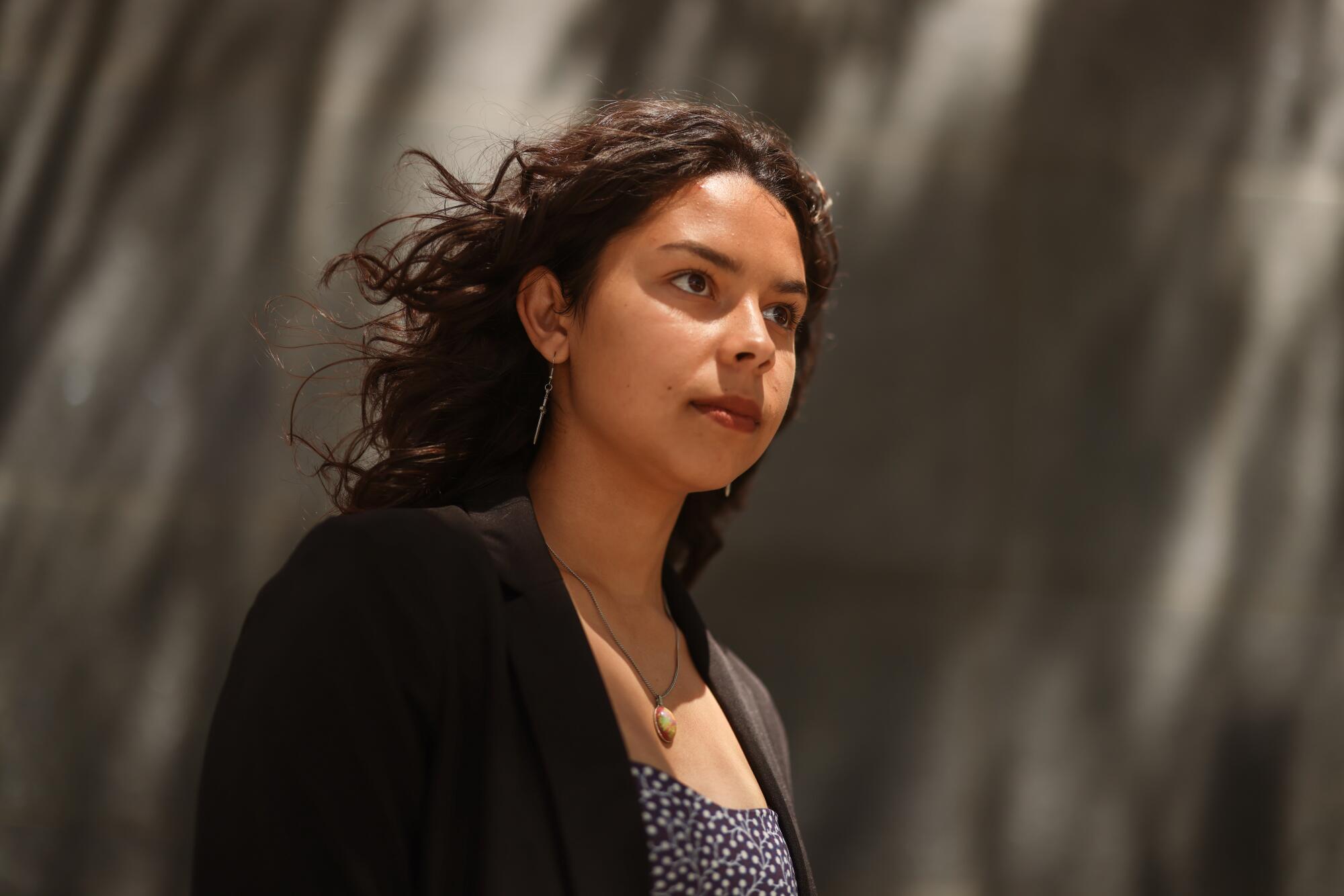
Maya, one of the plaintiffs who sued the EPA, organizes for Youth Climate Strike Los Angeles.
(Dania Maxwell / Los Angeles Times)
She also turned to collective action, first by joining her school’s Human Rights Watch student task force chapter, and then by volunteering with a club that successfully advocated for the Santa Monica-Malibu Unified School District to switch to 100% renewable energy and for its school board to adopt a climate literacy resolution directing staff to integrate climate lessons into the curriculum.
She now organizes with Youth Climate Strike Los Angeles, whose members have rallied outside City Hall and dressed up in Squid Game costumes to stage a die-in at the L.A. Auto Show. Maya wore blue overalls as a nod to Hyundai workers and in particular, child laborers, she said; the U.S. Department of Labor recently sued Hyundai over the use of child labor in Alabama.
“There’s a tremendous amount of pressure on youth right now because we will be the ones that, at the end of the day, will be suffering the consequences. Our future is at stake,” she said. “I’m definitely terrified — I’m not going to lie. I think every day we inch closer to a tipping point and the point of no return. But I’m also very hopeful, and I try to be more hopeful than terrified.”
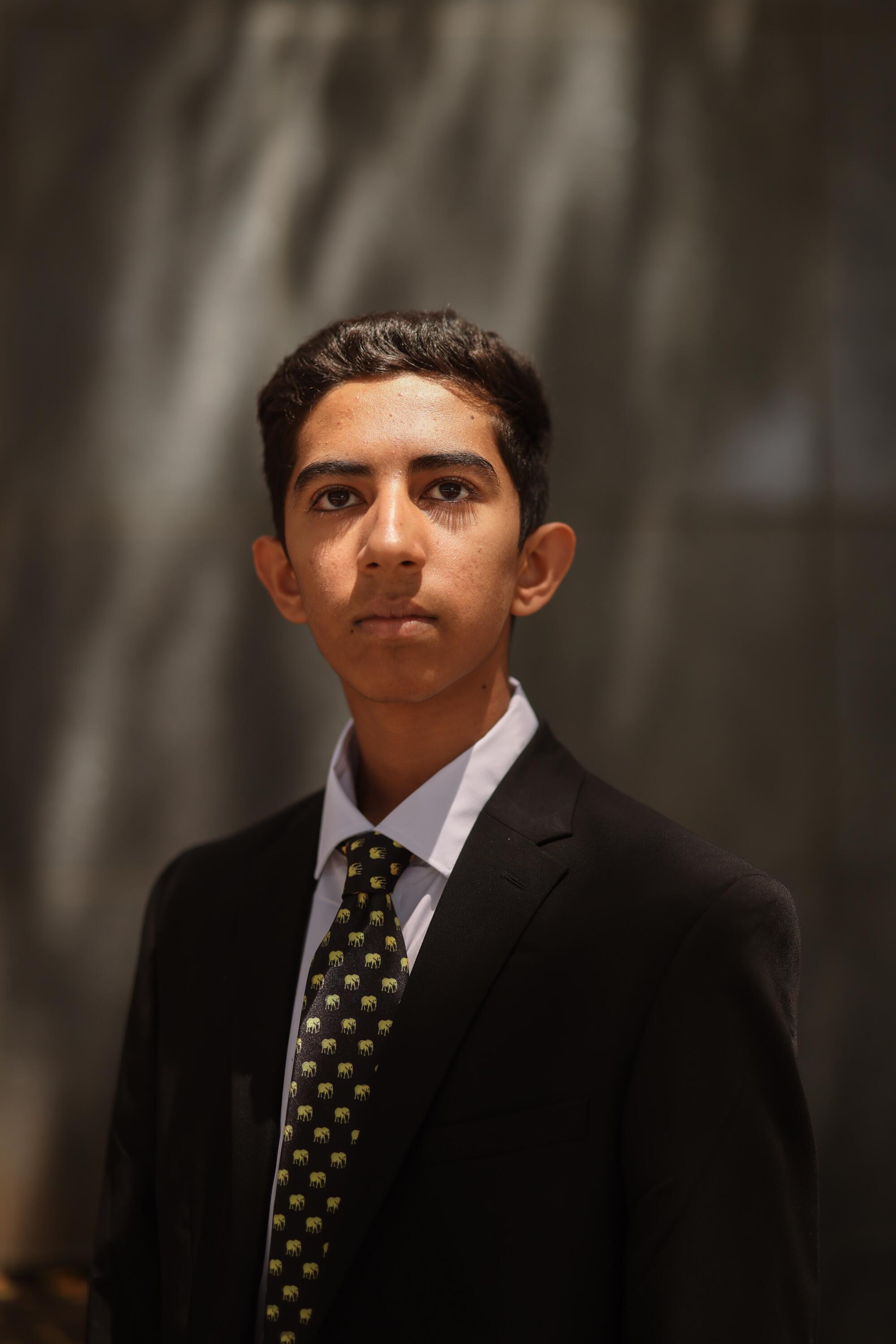
Avroh, another of the plaintiffs in the EPA suit, volunteers with multiple groups, including the Palo Alto Student Climate Coalition.
(Dania Maxwell / Los Angeles Times)
Avroh, 15, another party to the lawsuit, developed severe nosebleeds after a string of bad fire seasons that began when he was in the fourth grade. He had a blood vessel cauterized in his nose and began checking the air quality each morning to see if it was safe to go outside.
In late 2022, much of California swung wildly from drought to deluge. There were times the Palo Alto teen couldn’t leave his house because water would flood in if he opened the door. Last year, his school had to evacuate twice due to rain.
“So at that, I was like ‘OK, this is getting really bad,’” he said. “It’s not climate change in the future. It’s climate change now.”
Like the other teens, Avroh has found an outlet in activism. When he was 8, he started a club at his school that organized weekend cleanups on campus and at a nearby park. He now volunteers with multiple groups, including the Palo Alto Student Climate Coalition, which urges people to lower their carbon footprints, organizes climate literacy presentations and meets with elected officials.
“I really don’t enjoy this,” he said. “I’d rather be playing soccer or something. But instead, here I am, suing the Environmental Protection Agency.”

Climate change is a global crisis, but some communities are particularly vulnerable to its health effects. Legacies of redlining and racially restrictive covenants mean that low-income and nonwhite residents are disproportionately concentrated in these areas, which tend to have higher risk exposure to flooding, storm damage and large wildfires; more oil and gas wells; and less tree cover to mitigate extreme heat.
These dynamics inspired Sam Adeyeye to become a climate activist in the seventh grade. He wanted to stop a terminal for exporting coal that was planned in West Oakland, where many of his family members and friends lived. Adeyeye knew a lot of people with asthma who already were breathing some of the most polluted air in the Bay Area, made worse by stifling heat waves that have grown longer and more intense.
“Me preventing that would help them in the long run, would cause less asthma rates in West Oakland,” said Adeyeye, who is now a 17-year-old incoming freshman at UCLA and an organizer with Youth Vs Apocalypse, a climate justice organization that grew out of the campaign against the coal terminal. “And it would be inequitable for it to be there in the first place.”
After years of petitions, protests and legal wrangling, a judge recently green-lit the terminal, although the project remains on pause as the city of Oakland appeals. Adeyeye is now campaigning for the California State Teachers Retirement System to divest from fossil fuels, including by drumming up support for a bill that would achieve that goal.
“I come from a low-income community, so I want my conditions to improve — not only for myself but for the people that are younger, the newer generation that’s coming in, so they won’t have to go through what I’ve gone through,” he said.
“What makes me want to change the world is I know what it looks like for the world, for me, to be bad,” he added.

Traversi first coped with the trauma of losing her home by not really thinking about it. But when she turned 16 and got her driver’s license, she began to regularly drive back to the burned lot to journal and grieve. She started to have vivid memories of the night of the fire, recalling how her mother sang Prince songs in the car to try to keep her calm as they sped away. And she realized she’d never fully processed the event.
“I think I’m processing a lot to this day,” she said, recalling how PTSD symptoms reemerged when she and her mother moved into a new house this past January.
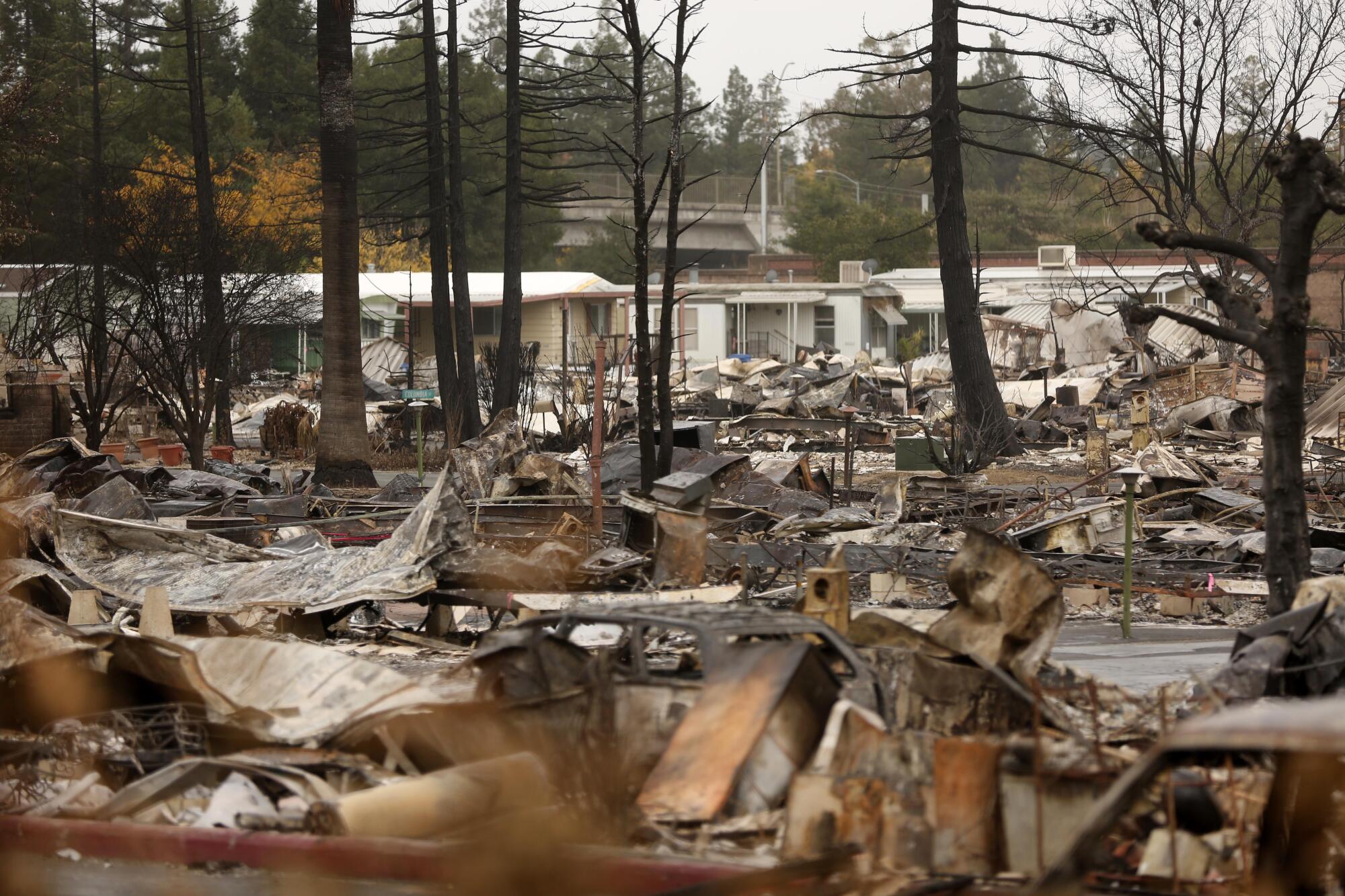
Santa Rosa’s Journey’s End Trailer Park stands in ruin in November 2017.
(Genaro Molina / Los Angeles Times)
In high school, Traversi joined a grassroots organization called Schools for Climate Action that was formed in the aftermath of the Tubbs fire and advocates for local school boards to pass climate resolutions. Together with fellow activist Giselle Perez, she co-wrote a U.S. House resolution raising awareness about youth climate anxiety and calling for more funding to support related resources.
Rep. Mike Thompson (D-St. Helena), who introduced the measure, said it was an honor working with Traversi to craft it. “As climate-related disasters become more common, Madigan has stepped up as a young leader to help shine a spotlight on the climate anxiety gripping so many of her peers,” he said in a statement.
“Activism has been a really healing outlet, because I’m able to see tangible change,” said Traversi, who is now studying rhetoric and theater and performance studies and serves on the advisory board of a group called the Climate Mental Health Network, which does outreach about the mental health impacts of climate change.
She insists that her experience, while dramatic, is not particularly unique. Virtually every person in her age group she’s spoken to has confided that they’re afraid they may die from the effects of climate change, or that they’re reluctant to consider having children in the future, she said.
“People really are experiencing the effects of climate change in that extreme of a way,” she said. “And I don’t know that anyone is not experiencing it at this point.”
